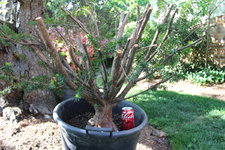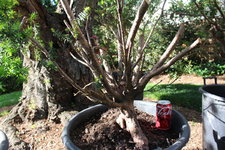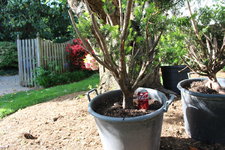I recently lucked into these 3 yews that were removed from someone's yard and the yard crew let me take them. I don't know what variety they are exactly, but around here (Dc area) it's mostly dwarf yews used for low hedging and I think that's what they are. Anyway, due to lack of space I would like to sell these (even though I'd love to design and work on them myself, it's unfortunately a luxury I don't have at the moment). I am seeking advice on how to price pre-bonsai like these. They could be anywhere from 20-40 years old, and they are really nice quality, but anyway, I'll let the pics do the talking.
You are using an out of date browser. It may not display this or other websites correctly.
You should upgrade or use an alternative browser.
You should upgrade or use an alternative browser.
How to price pre-bonsai? Advice needed
- Thread starter aurea
- Start date
Colorado
Masterpiece
Personally, I just use the good ole Eyeball Test. There is no exact science to it. Some will likely think the price is too high, some will likely think the price is a steal, and some will probably think the price is about right.
The one objective piece of the equation is the price of the pot, but that doesn’t really apply here since they’re not in bonsai pots.
Perhaps you already know this, but it is generally considered poor seller’s etiquette to sell collected (from the field, urban environment, or forest, doesn’t really matter) trees before they are recovered and established. However, if this fact is disclosed then it’s no problem …. But does impact the price in my opinion.
Are you looking for opinions on what price to ask for on these particular yews?
The one objective piece of the equation is the price of the pot, but that doesn’t really apply here since they’re not in bonsai pots.
Perhaps you already know this, but it is generally considered poor seller’s etiquette to sell collected (from the field, urban environment, or forest, doesn’t really matter) trees before they are recovered and established. However, if this fact is disclosed then it’s no problem …. But does impact the price in my opinion.
Are you looking for opinions on what price to ask for on these particular yews?
RoadManDenDron
Shohin
Personally I would never sell collected material until at least 1 year after collection
And even then, only if its clearly vigorous.
If you are determined to sell them early they should be cheap! It's a gamble for the buyer
And even then, only if its clearly vigorous.
If you are determined to sell them early they should be cheap! It's a gamble for the buyer
Thanks, guys, for your responses! Yes, if it was up to me, I would keep them for at least a year to get them established and see if they survive. I did also take pictures of the root balls before I potted them to show prospective buyers that they came with a large root system.
Because I don't have the space to keep these for a year I am kind of forced to sell them. I will definitely disclose all this information to buyers.
With all that in mind, what kind of pricing are we looking at for recently harvested, gamble material?
Because I don't have the space to keep these for a year I am kind of forced to sell them. I will definitely disclose all this information to buyers.
With all that in mind, what kind of pricing are we looking at for recently harvested, gamble material?
Personally, I just use the good ole Eyeball Test. There is no exact science to it. Some will likely think the price is too high, some will likely think the price is a steal, and some will probably think the price is about right.
The one objective piece of the equation is the price of the pot, but that doesn’t really apply here since they’re not in bonsai pots.
Perhaps you already know this, but it is generally considered poor seller’s etiquette to sell collected (from the field, urban environment, or forest, doesn’t really matter) trees before they are recovered and established. However, if this fact is disclosed then it’s no problem …. But does impact the price in my opinion.
Are you looking for opinions on what price to ask for on these particular yews?
Personally I would never sell collected material until at least 1 year after collection
And even then, only if its clearly vigorous.
If you are determined to sell them early they should be cheap! It's a gamble for the buyer
Listen to Colorado, he recently sold trees successfully for much more than I expected.
Also, since you say you got them a short while ago: Big yews can take half a year to die, easily.
Colorado
Masterpiece
Thanks, guys, for your responses! Yes, if it was up to me, I would keep them for at least a year to get them established and see if they survive. I did also take pictures of the root balls before I potted them to show prospective buyers that they came with a large root system.
Because I don't have the space to keep these for a year I am kind of forced to sell them. I will definitely disclose all this information to buyers.
With all that in mind, what kind of pricing are we looking at for recently harvested, gamble material?
I would guess that these could be sold in the $200-$300 range, given all of the circumstances.
Pitoon
Imperial Masterpiece
You clearly took them to sell knowing you had no space. Those trees should not be bought nor sold, they need time to recover. Be a respectable seller and let them recover verse trying to make a quick buck.
19Mateo83
Masterpiece
ThisYou clearly took them to sell knowing you had no space. Those trees should not be bought nor sold, they need time to recover. Be a respectable seller and let them recover verse trying to make a quick buck.
Bonsai Nut
Nuttier than your average Nut
It is a tough call. Picking up some landscape yews that might otherwise be thrown out - great. Trying to immediately flip them to make some cash... tougher call. I'm not against selling stock to make a profit, but the challenge here is that you only want to sell a tree if you can guarantee its health (to the extent that you can). On the west coast we regularly would encounter people who would drive out east, yank California junipers out of the desert without getting enough roots, and then try to resell them before they would die. People would sometimes pay four figures for a good-looking California juniper that had a limited chance of survival.
For what it's worth, you may have seen my recent posts of pulling twenty 50-year old Japanese hollies out of my landscape before I demoed a house on my property. It took me a year to prune them prior to collection, then dig them up, do the necessary secondary pruning, root pruning, and repot into Anderson flats. This doesn't include the $200 in Japanese pumice and pine bark fines just for these trees. And I still wouldn't consider selling them for at least a year. Most look good, some show some signs of stress or branch loss, and one I may lose because it was placed where it got a little too much direct sun. But I wouldn't sell them until I knew they were established in the new flats, and were showing signs of strong growth. And I wouldn't know that for a year.
For what it's worth, you may have seen my recent posts of pulling twenty 50-year old Japanese hollies out of my landscape before I demoed a house on my property. It took me a year to prune them prior to collection, then dig them up, do the necessary secondary pruning, root pruning, and repot into Anderson flats. This doesn't include the $200 in Japanese pumice and pine bark fines just for these trees. And I still wouldn't consider selling them for at least a year. Most look good, some show some signs of stress or branch loss, and one I may lose because it was placed where it got a little too much direct sun. But I wouldn't sell them until I knew they were established in the new flats, and were showing signs of strong growth. And I wouldn't know that for a year.
Last edited:
rockm
Spuds Moyogi
For a collected yew with no foliage and probably extremely reduced root mass out of the ground only a few months? $50 max and that's being generous. Yews are very tough, but not immortal. They're conifers, but they can backbud on old wood. However they're also conifers, eliminating most of their foliage and their roots can kill them or set them back significantly . Anyone buying them is taking a very large risk they're not going to recover.
Even As established bonsai material, they will have some big challenges -- iffy nebari and branches coming from one level, both would require extensive work down the road.
Even As established bonsai material, they will have some big challenges -- iffy nebari and branches coming from one level, both would require extensive work down the road.
Paradox
Imperial Masterpiece
Yea was going to say with the risk of them not surviving, I'd pay no mire than $50 each.
Thanks everyone for your replies. I feel I should address this: I never had any intention of scamming potential buyers. Yes--I think I was a little overconfident that I could sell newly dug-up material. But hey, that's why I'm glad I posted here!
I'm a softy and hate seeing perfectly good plants go to waste, and that is why I rescued these from going to the dump despite my lack of time and space. I will reach out to local bonsai producers and ask them if they have any interest. If no one wants them, I'll either give them away or find a way to squeeze them into my space for a year
I'm a softy and hate seeing perfectly good plants go to waste, and that is why I rescued these from going to the dump despite my lack of time and space. I will reach out to local bonsai producers and ask them if they have any interest. If no one wants them, I'll either give them away or find a way to squeeze them into my space for a year
leatherback
The Treedeemer
Second this. I just received news that a Yew we collected last year March and had been green since then, over the course of the last 2 weeks browned up completely..Big yews can take half a year to die, easily.
As such, RIGHT NOW they are not much more than what you would pay a home owner to collect them from his yard. You could argue you did work on potting them up. But untill they have had a season of strong growth, they are just stumps waiting to potentially die.
Similar threads
- Replies
- 11
- Views
- 613
- Replies
- 8
- Views
- 903



